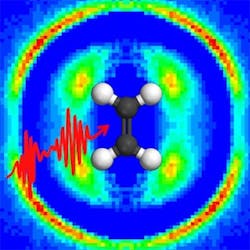| A laser drives a chemical reaction to form an unusual molecule; feedback consisting of a 3D velocity-map (a 2D cross-section is shown) conveys momentum data that helps scientists to improve the reaction. (Graphic: MPQ, Laboratory of Attosecond Physics) |
Sioux Falls, SD; Manhattan, KS; and Munich, Germany--Applied in the right place and the right time as chemicals interact, ultrafast laser pulses of the correct wavelength and duration can help produce molecules almost impossible to synthesize via chemical reactions alone.
In practice, even a single molecule is a complicated system and finding the correct laser pulse characteristics to influence molecules is difficult. In addition, laser pulse-shaping devices can produce a nearly infinite number of pulse shapes, making a systematic search for the correct laser-molecule solution daunting.
One existing approach is to use experimental feedback to guide an adaptive search of the possible laser pulses. As in natural selection, laser pulses that provide a better outcome are given an increased chance to survive and have their characteristics contribute to the tailored pulse that ultimately produces the desired outcome. Such a method, however, is only as good as the feedback that drives it.
3D velocity map
Now, researchers from Augustana College, Kansas State University (KSU), the Max Planck Institute for Quantum Optics (MPQ), and the Ludwig Maximilian University (LMU) have created an improved feedback technique. By imaging the dissociating molecule in 3D, a strong-field laser pulse can be optimized to drive the molecule to a very specific final state. This image-based technique, which involves rapidly inverting velocity-map images of ions, can complement feedback methods that depend on optical spectroscopy. Furthermore, the researchers were able to use the dissociation images to guide theoretical work that revealed how the laser pulse was able to control the molecule, in this case driving acetylene ions from the normal HCCH configuration to the unusual HHCC configuration.
Building on the initial work done at MPQ, Augustana students developed a method for converting the image into feedback quickly enough to be useful in the experiment. They then developed a system of computer control linking the entire experiment as well as refining image-analysis techniques to evaluate the experimental data. Once this was accomplished, the experiment itself was conducted at the J. R. Macdonald Laboratory at KSU. Initial results stimulated the theoretical work performed at LMU to clarify the control mechanism.
“The new methodology provides new possibilities for the control of more-complex systems including larger molecules, clusters, and nanoparticles,” says Matthias Kling, research group leader at MPQ and assistant professor at KSU at the time the studies were conducted. “Multidimensional data provide stricter limitations for theory and will help to improve our models,” adds Regina de Vivie-Riedle, professor at LMU and leader of the group that did the theoretical work.
Source: http://www.mpq.mpg.de/cms/mpq/en/news/press/13_12_06.html
REFERENCE:
1. E. Wells et al., Nature Communications 4 (2013) doi: 10.1038/ncomms3895
